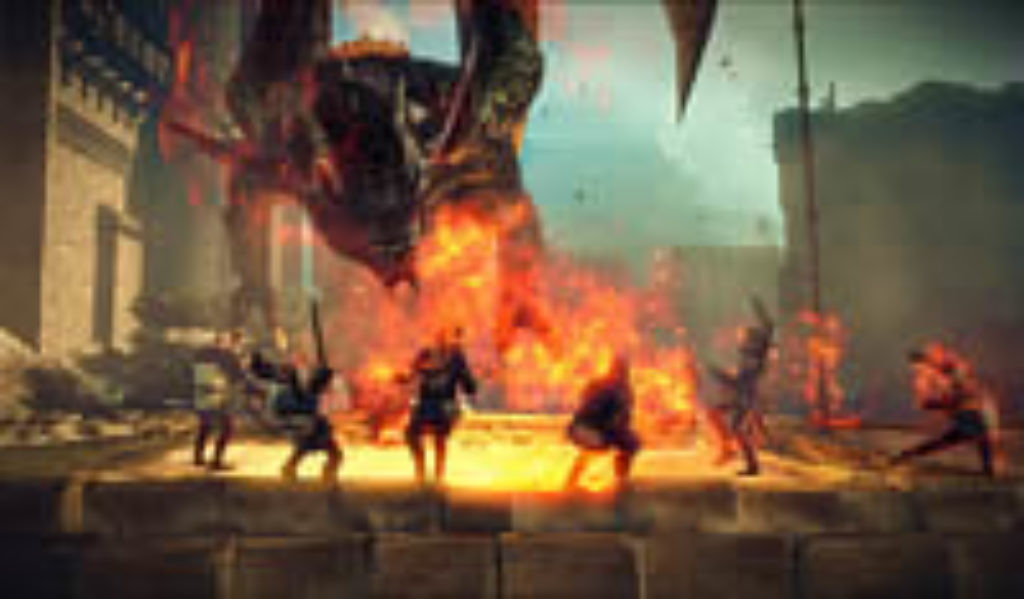
Being a witcher—”the offspring of foul sorcery and witchcraft”—might just earn you a reality TV show nowadays. In the fantasy world of this role-playing sequel, though, it’s not always a plus. It certainly isn’t easy being Geralt of Rivia. He has sword-swinging and magic-blasting skills that can certainly be helpful when a dragon attacks or a troll under the nearby bridge starts acting up, but the locals still sneer in his direction with distrust. Maybe it’s the yellow eyes. Maybe it’s the horridly scarred face and torso. Or maybe it’s the fact that most people think he killed the king.
Who Killed Who, Now?
The Witcher 2: Assassins of Kings is a follow-up to 2007’s hit role-playing original. And the sequel’s opening moments (I played the Xbox 360 “Enhanced Edition”) set the stage for what’s to come with a brutal assassination of a local monarch. Through the use of a sub-zero (freezing) magic potion and some raw brutality, a man-mountain of a killer slashes his way through the king’s forces and gruesomely hacks off the royal’s head.
From there we jump to a torture cell where Geralt is being whipped and manhandled for his role in the death. Or, wait, is it another kingly demise he’s being blamed for? As the game unfurls and flashes back to Geralt’s recent past we see that there isn’t just one unanswered question here—there are scores of them.
Not only was Geralt thought to be dead, but he has now mysteriously reappeared in the midst of a deadly scenario with little memory of where he’s been and what’s happened to him. And so it becomes the witcher’s quest to somehow escape his bonds, reclaim his memory piece by piece, find the real killer and cut through the political intrigue swirling around the group of murdered kings.
That lengthy to-do list will keep gamers going for at least 30 or 40 hours. And then there are all the side quests. Like many titles in this genre, the gaming action is divided up between bloody battling, dungeon trolling (gathering ingredients for magical potions and new weaponry) and escapades that slowly unravel the game’s twisting tale.
Players determine Geralt’s dialogue interactions and make choices about whether he’s going to be selfless or greedy, patient or deadly. Will he quickly draw his sword and kill for what he wants? Or wave his fingers with a subtle spell and get someone to give him what he needs without even touching his weapon? The interesting thing here, though, is that the choices made don’t determine Geralt’s heroism or vileness. Each action is viewed through an utterly amoral lens. You’re a selfless good guy? Cool. You’re a heartless battler? No problem. The choices shape which of a number of paths Geralt will take—sometimes fundamentally changing how his story plays out—but they don’t reinforce or even acknowledge the larger battle between good and evil.
The Amoral of the Story
This moral neutrality is revealed in several other evident ways as well. Much like an adult-oriented fantasy novel, The Witcher 2 delivers all the gore-dripping carnage and bodice-ripping carnality its participants might want to pursue. Sharp swords draw liberal levels of blood from huge humans, hunkering horrors and howling harpies alike. Cutscenes give even more up-close detail, showing us everything from a lice-riddled severed head to fleshy chunks of exploding sorceresses. The f- and s-word-filled conversations are raw, bouncing around between drunken humans, vengeful elves and crassly lustful dwarfs.
And where other recent games of this type (such as The Elder Scrolls V: Skyrim and Dragon Age II) cut away when things start getting steamy, The Witcher 2 revels in the heat. With a bit of in-game coin or a silver tongue, players can pursue intimate encounters with brothel prostitutes, female soldiers, a lusty succubus and Geralt’s main squeeze sorceress, Triss. In each case the camera captures and closely admires the kissing, caressing, coupling and naked lovers from various angles—keeping only Geralt’s genitalia hidden from view. Even if you want to hide that kind of action behind someone else’s closed door, there are moments of fully fleshed nudity that cannot be avoided.
This is a title with deep and involving gameplay. It bears (and bares) a story that can sometimes seem to allegorically mirror our real world with its political turmoil, racial tensions and social strife. But that unreserved reflection also earns every bit of its M rating.
GameSpot put it like this: “The Witcher 2 is a mature game indeed—not just because of its sexual themes and violent images, but because of its complex portrayal of morally ambiguous individuals struggling in a morally ambiguous world.”
Nobody’s actually calling The Witcher 2 “the offspring of foul sorcery and witchcraft”—but if the yellow eyes glow and the studded boots fit …

After spending more than two decades touring, directing, writing and producing for Christian theater and radio (most recently for Adventures in Odyssey, which he still contributes to), Bob joined the Plugged In staff to help us focus more heavily on video games. He is also one of our primary movie reviewers.